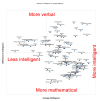Yet another veeeerrrrry interesting find today:

The five laws of behavioral genetics are:
This page is loaded with links to all kinds of furiously interesting things.

The Behavioral Genetics Page
This page is to make an easy to use (and easy to share) central repository for my posts on the science of behavioral genetics. This is fundamental reading for anyone interested in HBD – indeed for anyone interested in the human sciences in general. The Five Laws of Behavioral Genetics The five...
www.unz.com
This page is to make an easy to use (and easy to share) central repository for my posts on the science of behavioral genetics. This is fundamental reading for anyone interested in HBD – indeed for anyone interested in the human sciences in general.
The five laws of behavioral genetics are:
- All human behavioral traits are heritable
- The effect of being raised in the same family is smaller than the effect of the genes.
- A substantial portion of the variation in complex human behavioral traits is not accounted for by the effects of genes or families.
- A typical human behavioral trait is associated with very many genetic variants, each of which accounts for a very small percentage of the behavioral variability.
- All phenotypic relationships are to some degree genetically mediated or confounded.
This page is loaded with links to all kinds of furiously interesting things.


